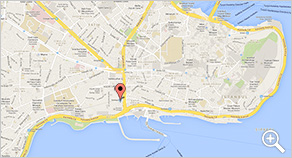YENİKAPI

In 2004, archaeological excavations at Üsküdar, Sirkeci, Sultanahmet and Yenikapı were undertaken by the Directorate of Istanbul Archaeological Museum within the framework of Marmaray and Metro rail link projects, which will connect the European and Asian continents via a tunnel under the Bosphorus. The archaeological remains and finds which were brought to light are of utmost importance to the cultural history of the world.
The city of Byzantion (Konstantinopolis after 330 AD) was founded at the strategic crossroads between Anatolia, the Balkans, and the passage from the Aegean to the Black Sea. This location contributed enormously to the growth of the city, which came to control the commercial routes, thanks to its harbors. The location of the Harbor of Theodosius was already known as “Langa” from both written sources and ancient maps, but its layout, size and exact position was unknown. The construction of this harbor was commissioned by Theodosius I (379-395 A.D.) to meet the needs of the Eastern Roman Empire’s rapidly growing new capital. The harbor was created by building a breakwater that ran from east to west along the south side of a deep natural bay. In addition to other structures, a large tower at the far end for guarding the harbor entrance, and silos for storing the grain brought by large ships from Alexandria and other ports, stood around the harbor. The excavation project undertaken in the harbor area since 2004 has unearthed more than 35,000 objects and a total of 36 ships, including merchant vessels and galleys, dating to the 7th to the 11th centuries. Falling prey to time, the Harbor of Theodosius silted up with alluvion carried by the Lycos (Bayrampaşa) River, whose waters emptied into the natural bay at the time the harbor was built, leaving it inland about a kilometer and a half from the Sea of Marmara coast. Farming activity and construction in the city also contributed to the silting process. The harbor remained operational until the mid-7th century before losing its importance due to the waste and rubble that were dumped into it, and the alluvial silting by the Lykos. The harbor stayed in service for small boats and ships until the late 11th century and was probably completely filled in during the 13th century.
The Department of Restoration and Conservation at Istanbul University was authorized to document, lift and undertake all conservation-restoration works as well as to prepare the shipwrecks for display at a specially purpose-built museum. Most of the shipwrecks found in the Harbor of Theodosius as a result of the excavations are at the eastern end near the harbor entrance. A quay made of rectangular stone blocks has been identified along a north/south axis at the westernmost edge of the harbor, inside the breakwater. The wooden piles that extend in two parallel rows immediately in front of the stone blocks probably belonged to a landing that served as an extension of the quay. Excavations underway in the northwest sector of the Metro area have revealed a church building constructed in the 13th century A.D., when the harbor had already begun to silt up. 23 graves have also been brought to light in the excavations in and around this church. A second landing, 4.8 meters wide and 11.7 meters long and built of closely-spaced piles, has been identified in the part of the harbor inside the Metro excavation area. A gold coin from the time of Justinian I (527-565 A.D.) was found in these excavations.
The wrecks provide much useful information about ships and ship-building in the 7th – 11th centuries. The most salient feature of these discoveries is the information they provide about trade, everyday life, the economy and religious beliefs in the period. Finds such as baked clay tablets inscribed with the names and places of origin of ship owners, stone and iron anchors, capstans and hawsers belonging to the sunken ships, and the image of a ship inscribed on an amphora dating to the 10th century are important in terms of providing information about shipping and ship types of the period. Additional artifacts include more than 2,500 wooden items such as bath clogs, combs and spoons of a dozen different varieties. A scale weight in the shape of a bust of Athena, a bronze balance and weights, lead tablets, bread stamps, a Christ figure, glass bowls with images of Christ, leather sandals, and tools made of bone and ivory reflect everyday life in the period. The excavation has uncovered these artifacts from various historical periods, the most recent of which is the late Ottoman era, while objects from the early Ottoman period, Byzantium, Rome, the classical period and the period before Christ have also been discovered. All the pieces are classified, and broken pieces are restored.
Reference:
Ufuk Kocabaş, “İstanbul Üniversitesi Bin Yıllık Bizans Batıklarını Kurtarıyor” İdol 8:30 (2006), 2-7.
Gün Işığında. İstanbul'un 8000 yılı: Marmaray, Metro, Sultanahmet kazıları. Istanbul: Vehbi Koç Vakfı, 2007.
Some selected examples (please click on pictures to enlarge):








